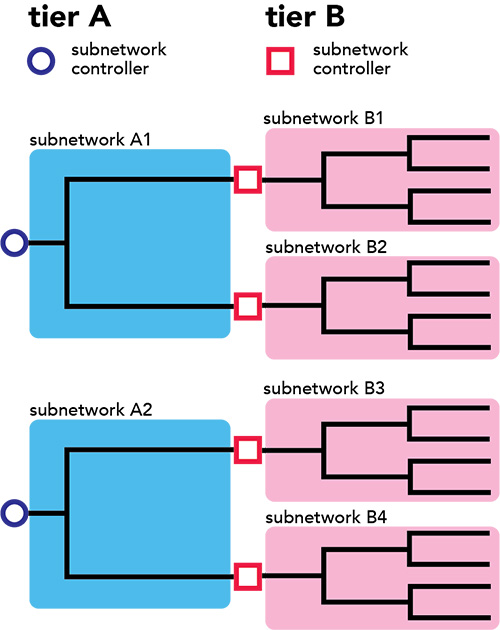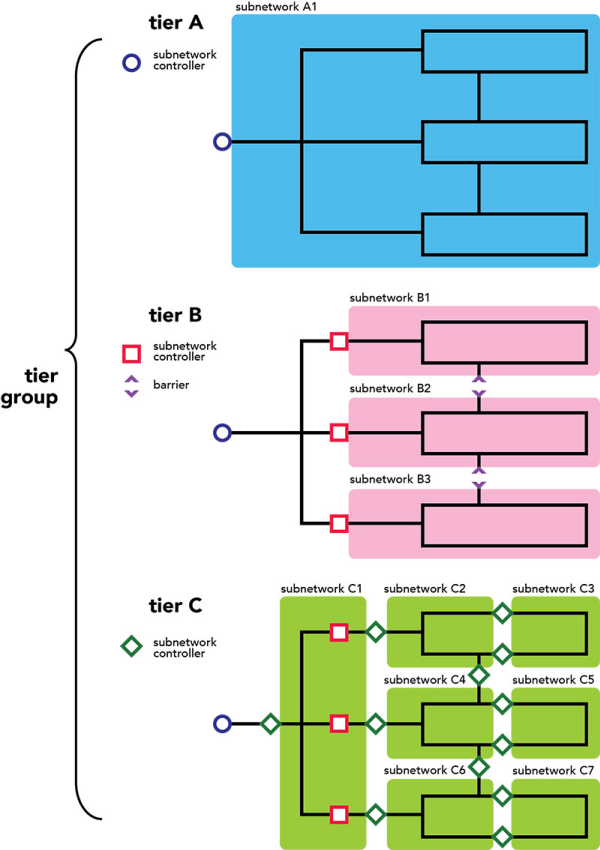Tiers are used to segregate and manage the final architectural piece of a network: subnetworks. A single tier defines a collection of individual subnetworks that all share the same properties and adhere to the same restrictions. Properties are defined when you add a domain network and create tiers for the utility network. These properties determine the layout of tiers and their position relative to the rest of the tiers in a domain network.
Tiers reside in either a domain network or a tier group, depending on the tier definition for the domain network. The structure network does not support tiers. In hierarchical domain networks, tiers reside in a tier group. In partitioned domain networks, tiers reside in a domain network, as tier groups are not modeled. A utility network can contain up to 63 tiers defined in a single or multiple domain networks.
Legacy:
Utility networks created at ArcGIS Pro 2.1 can have a maximum of 15 tiers.
Tiers are defined during the configuration stage of a utility network by the administrator. Tier properties allow you to define the topological organization of subnetworks in the tier and dictate a tier's position relative to the rest of the network. Some of these settings are restricted by the tier definition of the domain network where you're adding the tier.
To learn more about the architectural components and tools to model and manage subnetwork information, see Network management.
Tier definition
The tier definition is a property that's defined when you add a domain network to the utility network. A tier definition denotes the organization of the tiers relative to the rest of the network. In a domain network or tier group, two or more tiers can form a collection of partitioned, successive tiers or a hierarchy of nested tiers. In a utility network, all tiers in a domain network or tier group share the same tier definition. A utility network can have multiple domain networks with different tier definitions.
You can organize a domain network that is determined by the tier definition in the following ways:
- Partitioned—Supports systems that are sequential in nature, such as electrical and telecommunications utilities
- Hierarchical—Allows you to model networks that are nested, such as gas and water networks
The Tier Definition property can be viewed in the network properties of a utility network under the specific domain network.
Partitioned
Features in domain networks with a partitioned tier definition are independent and can only exist in one tier. Features can exist in one or multiple subnetworks. The relationship between tiers in partitioned domain networks is ordered and linear. For example, a transmission tier delivers the resource over a long distance, and a distribution tier serves the resource to the customer.
Barrier features or subnetwork controllers can act as boundary features between tiers. These features can belong to multiple subnetworks from different tiers.

Hierarchical
In domain networks with a hierarchical tier definition, the same feature can be modeled in multiple types of subnetworks. For example, pressure zones and isolation zones can be defined in two tiers within a tier group. A gas or water feature can be part of both the pressure and isolation tiers.

Topology type
When you add a new tier to a utility network, the topology type is defined during creation. Domain networks with partitioned tier definition support both mesh and radial tier topology types for subnetworks. Hierarchical domain networks only support tiers with mesh tier topology type, so this property of the tier is automatically defined when the tier is added.
- Radial—Consists of one or more subnetwork controllers
- Mesh—Consists of one or more subnetwork controllers
Note:
The topology type currently does not provide a difference in behavior for tracing or subnetwork management. The functionality is under development and will be applicable in a future release.For more information about tier topology types, see Subnetworks.
Tier rank
In a domain network, the relative position of a tier is called a rank. Ranks control the trace order of subnetworks from different tiers. A rank value is assigned to a tier when it's created. A value of 1 represents the highest rank, and higher numeric values represent tiers with lower rank.
Parallel ranks are supported for both tier definitions. For example, in a gas network, the System tier and Gathering tier can both have a rank of 3.
Partitioned
For domain networks with a partitioned tier definition, you assign the tier ranks. When you create a partitioned tier and don't assign a rank, the default rank is the lowest rank (highest number) plus 1. The new tier essentially becomes the lowest rank level. For example, if ranks 1, 2, 3, and 4 exist, the new tier would receive a rank number of 5, unless you specify otherwise. A tier can participate in only one rank, while one rank can have many tiers. In the previous example, you could assign the new tier a rank level of 3.
Hierarchical
Hierarchical tier ranks are automatically defined and cannot be altered. Therefore, when you configure hierarchical tiers, they must be added in order starting with the highest ranked tier, for example, 1, 2, 3, 4, and 5. The last tier added in hierarchical networks has the lowest rank. The first tier in a hierarchical network receives a rank of 1. The last tier in a domain network with 4 tiers has the lowest rank of 4. This ranking is on a per-tier group basis.